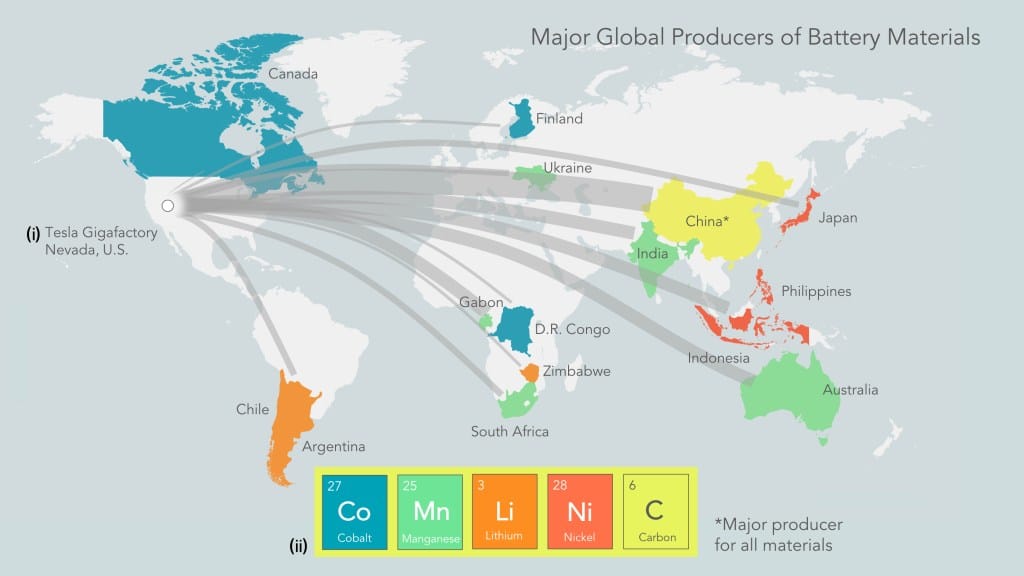
How Sustainable is Electric Vehicle Manufacturing?
Table of contents
In April 2020, Berkley Law Center for Law, Energy & Environment published a paper entitled, “Building a Sustainable Electric Vehicle Battery Supply Chain”. This research notes the considerable increase in demand for sustainable transportation solutions and recognizes that manufacturers are looking primarily to electric vehicles as the answer. With this, regulators are looking to improve and ensure the sustainability and transparency of electric vehicle supply chains.
In this blog we’ll look at typical EV battery supply chains, manufacturers and innovations that have the potential to shake up the market, and the ways in which supply chain digitalization can help to ensure sustainable EV battery manufacture.
How Sustainable Are EV Battery Supply Chains?
Much research has been done, and many comparisons have been made between the carbon footprints of electric and internal combustion engine (ICE) vehicles. Most agree that the total lifecycle emissions – combined manufacturing and operating – of electric vehicles average out at around 50% fewer than those of ICE vehicles.
https://www.law.berkeley.edu/wp-content/uploads/2020/04/Building-A-Sustainable-Electric-Vehicle-Battery-Supply-Chain.pdf
However, the manufacture of lithium-ion batteries is responsible for a generous portion of those emissions. In fact, research has previously shown that EV manufacturing CO2 emissions can outweigh those generated in ICE vehicle manufacture. This damage is worsened when refineries and supply chain manufacturers are operating in regions where coal-fired electricity is the norm, or when parts are shipped long-haul before reaching OEMs.
One method proposed to tackle this issue is lightweighting – which has been a crucial component of ICE chassis design and manufacture for decades. Many of the raw materials necessary for automotive manufacture are heavy. This equates to higher carbon emissions during extraction, refinement and transportation during manufacturing processes. In 2013, Volvo’s development of lightweight energy storage components came as a breakthrough. Using nanofibers and polymer resin, Volvo were able to mold, and form fit their batteries around the car frame.
This innovative diversification has since become a trend within automotive manufacturers. With about 40% of electric vehicle value residing in the battery itself, OEMs are reluctant to let that value go elsewhere. This is resulting in manufacturers localizing their manufacturing processes. Still, the issue of raw materials remains.
The diagram below shows Tesla’s raw material sourcing as plotted by Harvard researchers in 2019.
https://sitn.hms.harvard.edu/flash/2019/how-electric-cars-can-become-truly-green-once-and-for-all/
What Raw Materials Do Lithium-ion Batteries Need?
With around 60% of cobalt supply and 80% of reserves coming from small-scale mining in the Democratic Republic of Congo, automotive OEMs are being asked for transparency on the methods and means that are being used to acquire their raw materials.
Companies such as Panasonic are currently developing cobalt-free lithium-ion cells. At the Consumer Electronics Show, 2021, Panasonic unveiled their newest cells, which already contain less than 5% cobalt. Cobalt-free batteries will enable electric vehicle manufacturers to lower the cost of their vehicles by up to 30%. General Motors are also working, in collaboration with LG, to lower the amount of cobalt used in their EV batteries by swapping the element with aluminium.
While there’s plenty lithium to be mined, the current prices won’t support the investment necessary to mine it. And while there are sources of nickel in North America, Finland and Russia, most of the world’s nickel is refined in China and the Far East – making it cheaper for Western organization to ship refined nickel from overseas.
With such disruption ongoing in automotive supply chains, manufacturers operating with agile methodologies will inevitably be the first to succeed.
Manufacturing Sustainable Lithium-ion Batteries
Several advancements in our ability to recycle lithium-ion batteries components shine a positive light on the potential for a truly circular electric vehicle economy. It’s possible that we’ll begin to see a cascading reuse lifecycle for li-ion batteries in the coming years, where end-of-life EV batteries could be used as part of a “smart grid” to provide charging from stationary energy storage systems.
Currently, there are low volumes of EV batteries in need of reuse or recycling. But the recent, rapid expansion of the electric vehicle market may soon cause issues for recycling operations. Here, there are some lessons to be learned quickly from the lead-acid battery recycling industry. Lead-acid battery designs are relatively standardized and optimized for disassembly but with rapid innovation in li-ion battery technology, this has been a secondary concern.
In Our Experience…
The new reality that Automotive OEMs must face is that the consumer concerns that drove electric vehicle demand to the peak it’s approaching today, are the same concerns that demand transparency throughout the supply chain.
Consumers are holding manufacturers responsible for the decisions they make, the processes they apply, and the materials they use to provide their products and services. So, it’s crucial that planning and communication throughout supply chains are closely aligned and up-to-date. This is the major advantage of digital manufacturing solutions, like DELMIA, which help to bring people, processes and data together from across your organization and the entire supply chain.
Catch up with the Automotive Spotlight PLM Innovation Forum!
Now available on demand.



